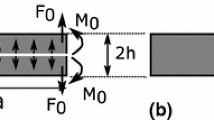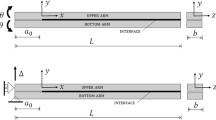Abstract
This paper discusses dynamic crack growth and arrest in an elastic double cantilever beam (DCB) specimen, simulated using the Bernoulli–Euler beam theory. The specimen is made from two different materials. The section of interest, where the dynamic crack growth takes place, is made from a material, the fracture energy of which will be denoted \(2\Gamma _1 \). The initial crack grows slowly in a starter material with a fracture energy \(2\Gamma _{0} \;(\Gamma _{0} >\Gamma _1 )\), while opposed displacements on both arms of the specimen are continuously increased. As the crack reaches the material interface at \(\ell =\ell _c \), the loading displacement is instantly suspended, and the crack suddenly propagates through the test zone, until it stops at \(\ell =\ell _A \). During this process, the energy \(2\Gamma _1 (\ell _A -\ell _c )\) is dissipated. The beam motion and the fracture process during the fast crack growth stage are investigated, based on the balance energy associated to the Griffith criterion. The motion equations are approximated using a modal decomposition up to order \(N\) of the beam deflection (the analysis has been performed up to \(N=10\) but in most cases \(N=5\) is sufficient to obtain an accurate solution). This process leads to a set of N second order differential equations whose unknowns are the mode amplitudes and their derivatives, and another equation the unknowns of which are the current crack length \(\ell (t)\), velocity \(\dot{\ell }(t)\) and acceleration \(\ddot{\ell }(t)\). To demonstrate the accuracy of this method, it is first tested on a one dimensional peeling stretched film problem, with an insignificant bending energy. An exact solution exists, accurately approximated by the modal solution. The method is then applied to the DCB specimen described above. Despite the rather crude nature of the Bernoulli–Euler model, the results crack kinematics, and specially the arrest length, correspond well to those obtained by the combined use of finite elements and cohesive zone models, even for a few modes. Moreover, for the basic mode \(N=0\) (also referred to as Mott solution), even if the crack kinematics is not accurately reproduced, the prediction of the crack arrest length remains correct for moderate ratios. Some parametric studies about the beam geometry and the initial crack velocity are performed. The relative crack arrest \(\ell _A /\ell _c \) appears to be almost insensitive to these parameters, and is mainly governed by the ratio \(R=\Gamma _{0} /\Gamma _1 \) which is the key parameter to predict the crack arrest.














Similar content being viewed by others
References
Freund LB (1989) Dynamic fracture mechanics. Cambridge University Press, ISBN 0-521-30330-3, 1998 (first edition)
Charlotte M, Dumouchel P-E, Marigo J-J (2008) Dynamic fracture: an example of convergence towards a discontinuous quasi-static solution. Contin Mech Thermodyn 20:1–19
Lazzaroni G, Bargellini R, Dumouchel P-E, Marigo J-J (2012) On the role of kinetic energy during unstable propagation in a heterogeneous peeling test. Int J Fract 175:127–150
Kanninen MF (1985) Applications of dynamic fracture mechanics for the prediction of crack arrest in engineering structures. Int J Fract 27:299–312
Kanninen MF (1973) An augmented double cantilever beam model for studying crack propagation and arrest. Int J Fract 9(1):83–92
Freund LB (1977) A simple model of the double cantilever beam crack propagation specimen. J Mech Phys Solids 25:69–79
Hellan K (1981) An alternative one-dimensional study of dynamic crack growth in DCB test specimens. Int J Fract 17(3):311–319
Mott NF (1948) Brittle fracture in mild steel plates. Engineering 165:16–18
Burns SJ, Webb WW (1970) Fracture surface energies and dislocation processes during dynamical cleavage of LiF. I. Theory. J Appl Phys 41(5):2078–2085
Wang Y, Williams JG (1996) Dynamic crack growth in TDCB specimens. Int J Mech Sci 38(10):1073–1088
Jagota A, Rahul-Kumar P, Saigal S (2002) Natural frequencies of stable Griffith cracks. Int J Fracture 116:103–120
Debruyne G, Dumouchel PE, Laverne J (2012) Dynamic crack growth: analytical and numerical cohesive zone models approaches from basic tests to industrial structures. Eng Fract Mech 90:1–29
Author information
Authors and Affiliations
Corresponding author
Additional information
Radhi Abdelmoula is a invited researcher at LaMSID-EDF-CEA, 1 avenue du Gal de Gaulle 92141 Clamart, France.
Appendix: Energy derivation for the DCB test
Appendix: Energy derivation for the DCB test
Local motion equations derived from the enrgy balance:
It is deduced that:
and that \(\frac{\partial K}{\partial \dot{q}_i }\dot{q}_i =2K\) (for the stationary crack the kinetic energy is a quadratic form, for the growing crack, this property cancels but the energy keeps the property \(\frac{\partial K}{\partial \dot{a}_i }\dot{a}_i +\frac{\partial K}{\partial \dot{\ell }}\dot{\ell }=2K)\)
That leads to:
Inserting this relation in (I), it comes:
That says:
Selecting an arbitrary number of modes \(N\), and making the difference of the relations (II) for \(N\) and \(N+1 \quad \dot{q}_i \), the following relations hold for each occurrence:
Application to the DCB test:
Using the relation (8), the kinetic and elastic energy relations for N modes are expressed as (with the Einstein summation convention):
The above expression of \(K(a_i ,\dot{a}_i ,\ell ,\dot{\ell })\) is clearly a \(2^\mathrm{nd}\) order homogeneous function of \((\dot{a}_i ,\dot{\ell })\).
Deriving \(K-U\) with respect to \((\dot{a}_i ,a_i )\) leads to :
Therefore, the Eq. (24) lead to the following differential system (using the Einstein summation convention on the index j):
with the following coefficients :
In the same way, deriving \(H=K+U+\Gamma _1 (\ell -\ell _c )\) with respect to \((\ell ,\dot{\ell })\) leads to :
The equation relative to the Griffith criterion leads to the single differential equation:
with \(\Delta =C_1 +a_i a_j C_2^{ij} +2a_i C_3^i \).
Application to the peeling test:
the kinetic and elastic energy relations for N modes are expressed as (using the Einstein summation convention) :
Applying the same process than for the DCB case, and deriving \(K-U-D\) with respect to \((a_i ,\dot{a}_i )\) and to \((\ell ,\dot{\ell })\), the following equations hold :
Rights and permissions
About this article
Cite this article
Abdelmoula, R., Debruyne, G. Modal analysis of the dynamic crack growth and arrest in a DCB specimen. Int J Fract 188, 187–202 (2014). https://doi.org/10.1007/s10704-014-9954-4
Received:
Accepted:
Published:
Issue Date:
DOI: https://doi.org/10.1007/s10704-014-9954-4




